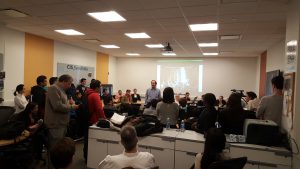Self-driving cars are here and they are revolutionizing the automobile and the transport industry to a large extent. Honda Motors and Tesla Motors already have some vehicles on the market and Ford predicts to have a self-drive vehicle ready in the next 5 years.
The companies promise that self-drive cars not only will make the roads safer but also reduce costs related to transportation.
Singapore became the first country to launch the self-driving taxi service and Uber announced that it will launch its own trial of self-drive cars in Pittsburgh.
So, what is a self-drive car?
An autonomous car (driverless car, self-driving car, robotic car) is a vehicle that is capable of sensing its environment and navigating without human input.Autonomous cars can detect surroundings using a variety of techniques such as radar,lidar,GPS etc
.
Let’s take a look at some of the technology behind this invention :
LIDAR: Laser Illuminating Detection and Ranging : is used to build a 3D map and allow the car to “see” potential hazards by bouncing a laser beam off of surfaces surrounding the car in order to accurately determine the distance and the profile of that object.
The Google Car uses a Velodyne 64-beam laser in order to give the on-board processor a 360-degree view by mounting the LIDAR unit to the top of the car (for unobstructed viewing) and allowing it to rotate on a custom-built base.
While LIDAR is great for accurately mapping surroundings, its one fatal flaw is in its ability to accurately monitor speed of surrounding vehicles in real time. This is where the four bumper-mounted radar units pick up the slack.
With two sensors in the front bumper, and two in the rear, the radar units allow the car to avoid impact by sending a signal to the on-board processor to apply the brakes, or move out of the way when applicable. This technology works in conjunction with other features on the car such as inertial measurement units, gyroscopes, and a wheel encoder in order to send accurate signals to the processing unit (the brain) of the vehicle in order to better make decisions on how to avoid potential accidents.
High Powered cameras:
The actual camera technology and setup on each driverless car varies, but one prototype uses cameras mounted to the exterior with slight separation in order to give an overlapping view of the car’s surroundings. This technology is not unlike the human eye which provides overlapping images to the brain before determining things like depth of field, peripheral movement, and dimensionality of objects.
Each camera has a 50-degree field of view and is accurate to about 30 meters. The cameras themselves are quite useful, but much like everything else in the car they are redundant technology that would allow the car to work even if they were to malfunction.
Sonar:
Again, each prototype car built by Google is slightly different, but some of those tested have featured advanced sonar technology. The limitations of sonar are its narrow field of view and its relatively short effective range (about 6 meters). However, the inclusion provides yet another redundant system that allows the car to effectively cross-reference data from other systems in real time to apply the brakes, pre-tension seat belts for impact, or swerve to avoid obstacles.
Positioning:
A car with no steering wheel, no brakes and no accelerator would be essentially useless without advanced positioning systems to track its course and plot an appropriate route to its destination. For this challenge, Google uses its own map system, as well as GPS satellites, inertial measurement units, and a wheel encoder to determine actual speed. The system works alongside the on-board cameras to process real-world information as well as GPS data, and driving speed to accurately determine the precise position of each vehicle, down to a few centimeters all while making smart corrections for things like traffic, road construction, and accidents.
Sophisticated Software:
The learning algorithm processes the data of not just the car you’re riding in, but that of others in order to find an appropriate response to each possible problem. Behavioral dynamics are also mapped and this data is used to help recognize situations before they happen, much like a human driver. For example, the cars are smart enough to recognize – and adapt to – situations such as:
A slow-moving vehicle in the right line suggests a higher probability that the car following it will attempt to pass.
- A pot hole or foreign item in the street shows a higher probability of a driver swerving to avoid it.
- Congestion in the left lane means that drivers are more likely to attempt to enter the right lane.


